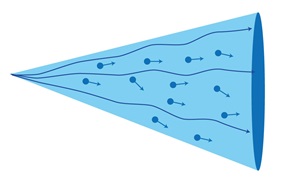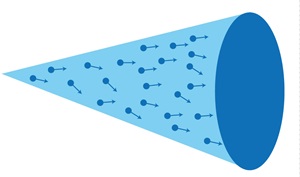 Guide to efficient tank cleaning
Guide to efficient tank cleaning
Previous: Part 2 - Efficiency gains
Part 3 : The Quick Win of improve mechanical action
Often the simplest absolute efficiency gains can be found by improving the mechanical
action element of the mix. These gains can then be deployed to reduce other elements
of the mix as appropriate. The importance of nozzle selection For any impact cleaning process water serves two purposes. Firstly it acts to dissolve residue - this is part of the chemical element of cleaning mentioned above. More importantly, however, water is the mechanism by which the mechanical action element is delivered. The efficiency of a water spray for delivering mechanical energy for cleaning will be greatly affected by the nature of the spray and thus the nozzle used.
Improving the efficiency of mechanical action
Mechanical action is essentially the process of transferring energy from a pump to the surface to be cleaned via water. As with all energy transfer systems efficiency is always less than 100%. Much energy is wasted but by reducing this waste through improved nozzle selection we can significantly improve the efficiency of the tank washing system. If this is achieved then we can reduce the amount of energy/water used and achieve the same or greater level of mechanical action.

Effects of Fluid breakup
The process of breaking apart a fluid into droplets or multiple streams to form a spray
pattern uses energy. This, once used, is then not available for cleaning the surface in
question. In tank cleaning applications fluid will be delivered in 3 basic spray patterns.
 Solid stream – this is a simple jet of water and will impact the tank surface as a small
Solid stream – this is a simple jet of water and will impact the tank surface as a small
dot. Solid stream nozzles do not atomise the fluid and it remains as a constant stream of liquid. As such they preserve the majority of the energy resulting in maximum impact.
 Flat fan – The fluid is widened into triangle shaped spray. It will impact the surface as
Flat fan – The fluid is widened into triangle shaped spray. It will impact the surface as
a thin line of spray. Fan nozzles generally produce a sheet of fluid with little atomisation,
although some droplets will form. The formation of the sheet and the droplets takes a considerable amount of energy out of the liquid meaning impact is medium.
 Full Cone – The fluid is again widened into a cone shape and there is a relatively even distribution of fluid within the cone. It will thus hit the tank walls as a filled in circle of spray. A large degree of atomisation occurs with this pattern meaning almost all the energy is used to break the fluid apart. This means impact on the tank wall is minimal.
Full Cone – The fluid is again widened into a cone shape and there is a relatively even distribution of fluid within the cone. It will thus hit the tank walls as a filled in circle of spray. A large degree of atomisation occurs with this pattern meaning almost all the energy is used to break the fluid apart. This means impact on the tank wall is minimal.
Turbulence
Further energy will be lost in sprays due to turbulent flow. In solid stream and, to a lesser degree, flat fan nozzles the fluid will be flowing in an unatomised state. This does not, however, mean that all the liquid is moving in a uniform direction at all times. Ideally we would want every water molecule to move in the direction of the stream. This idealised motion would result in the most efficient energy transfer. This perfect laminar flow is best for energy transfer. The more turbulent the flow becomes the more energy is wasted and the more the stream starts to break up.
As a result of turbulence not all solid stream flows are equal when it comes to energy transfer. The quality of the stream will depend very much on the quality of the nozzle forming it. With spray balls the multiple streams formed are technically solid streams but the nozzle that forms them is simply a hole in a metal sphere and so are low quality. The resultant streams are unstable and lack coherence and, as such, they tend towards turbulent flow very quickly. In contrast the jets formed by rotary tank cleaners will be formed by long nozzles with flow stabilisers built in This means that these streams will remain laminar for longer.
Not all solid streams are equal
The diagrams below illustrate how turbulence and stream breakup can vary between
different solid stream jets.

Idealised laminar flow. This will give the maximum energy transfer.
 Good laminar flow. Typical flow from high quality nozzles. The jet will maintain integrity at a good distance from the nozzle. Energy transfer is good.
Good laminar flow. Typical flow from high quality nozzles. The jet will maintain integrity at a good distance from the nozzle. Energy transfer is good.
 Poor laminar flow. Typical flow from
Poor laminar flow. Typical flow from
spray balls and low quality nozzles.
The jet will quickly break up and energy transfer is poor.
Notes on pressure
It would seem logical that increasing pressure will improved the mechanical action of any tank washer. This, however, is only partly true. For cone pattern and the flat fan patterns formed by spinning spray balls if the pressure goes much above 1.5-2 bar little gains in impact will be delivered. This is because the flows are so unstable that most of the extra energy will be used to atomise or break up the fluid. The extra energy put into the system is effectively wasted.
Similarly the nozzles that form the streams on spray balls will produce very unstable jets. As pressure goes beyond a couple of bar the instability of the jets means that they will tend to atomise and break up. So, again, energy just tends to be wasted in running spray balls at higher pressures.
With rotary jet nozzles the story is somewhat different. As they use flow stabilising nozzles most will hold coherent jets at 10 bar or more. Above this, though, there will be diminishing returns as even these quality streams will begin to break apart at higher velocities. Increasing pressure will also decrease the cycle time as the jetting arms will rotate faster. At higher pressures the jets may be rotating so fast that this perpendicular motion causes the stream to loose coherence. Normally the optimum pressure for rotary jet nozzles is about 8-10 bar.
Mechanical action - conclusions
The most efficient spray system would be solid stream jet followed by a flat fan spray pattern and finally a full cone pattern. Spray balls, despite forming multiple mini solid streams are best considered as full cone patterns in terms of energy transfer efficiency.
The efficiency differences are considerable. Changing from spray balls to solid stream nozzles will result in a dramatic increase in mechanical action for the same flow rates of water. This is an absolute gain in efficiency that can greatly affect the overall efficiency of the tank clean.